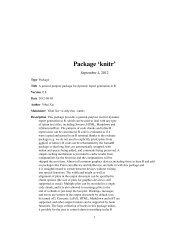Package 'openair'
Package 'openair'
Package 'openair'
Create successful ePaper yourself
Turn your PDF publications into a flip-book with our unique Google optimized e-Paper software.
82 polarAnnulusnormalise = FALSE, key.header = "",key.footer = pollutant, key.position = "right",key = TRUE, auto.text = TRUE, ...)Argumentsmydatapollutantresolutionlocal.timeperiodtypeA data frame minimally containing date, wd and a pollutant.Mandatory. A pollutant name corresponding to a variable in a data frame shouldbe supplied e.g. pollutant = "nox". There can also be more than one pollutantspecified e.g. pollutant = c("nox", "no2"). The main use of usingtwo or more pollutants is for model evaluation where two species would be expectedto have similar concentrations. This saves the user stacking the data andit is possible to work with columns of data directly. A typical use would bepollutant = c("obs", "mod") to compare two columns “obs” (the observations)and “mod” (modelled values).Two plot resolutions can be set: “normal” and “fine” (the default).Should the results be calculated in local time? The default is FALSE. Emissionsactivity tends to occur at local time e.g. rush hour is at 8 am every day. Whenthe clocks go forward in spring, the emissions are effectively released into theatmosphere at BST — 1 hour during the summer. When plotting diurnal profiles,this has the effect of “smearing-out” the concentrations. A better approachis to express time as local time, which here is defined as BST (British SummerTime). This correction tends to produce better-defined diurnal profiles of concentration(or other variables) and allows a better comparison to be made withemissions/activity data. If set to FALSE then GMT is used.This determines the temporal period to consider. Options are “hour” (the default,to plot diurnal variations), “season” to plot variation throughout the year,“weekday” to plot day of the week variation and “trend” to plot the trend bywind direction.type determines how the data are split i.e. conditioned, and then plotted. Thedefault is will produce a single plot using the entire data. Type can be one ofthe built-in types as detailed in cutData e.g. “season”, “year”, “weekday” andso on. For example, type = "season" will produce four plots — one for eachseason.It is also possible to choose type as another variable in the data frame. If thatvariable is numeric, then the data will be split into four quantiles (if possible)and labelled accordingly. If type is an existing character or factor variable, thenthose categories/levels will be used directly. This offers great flexibility for understandingthe variation of different variables and how they depend on oneanother.Type can be up length two e.g. type = c("season", "site") will producea 2x2 plot split by season and site. The use of two types is mostly meant forsituations where there are several sites. Note, when two types are provided thefirst forms the columns and the second the rows.Also note that for the polarAnnulus function some type/period combinationsare forbidden or make little sense. For example, type = "season" and period = "trend"
















